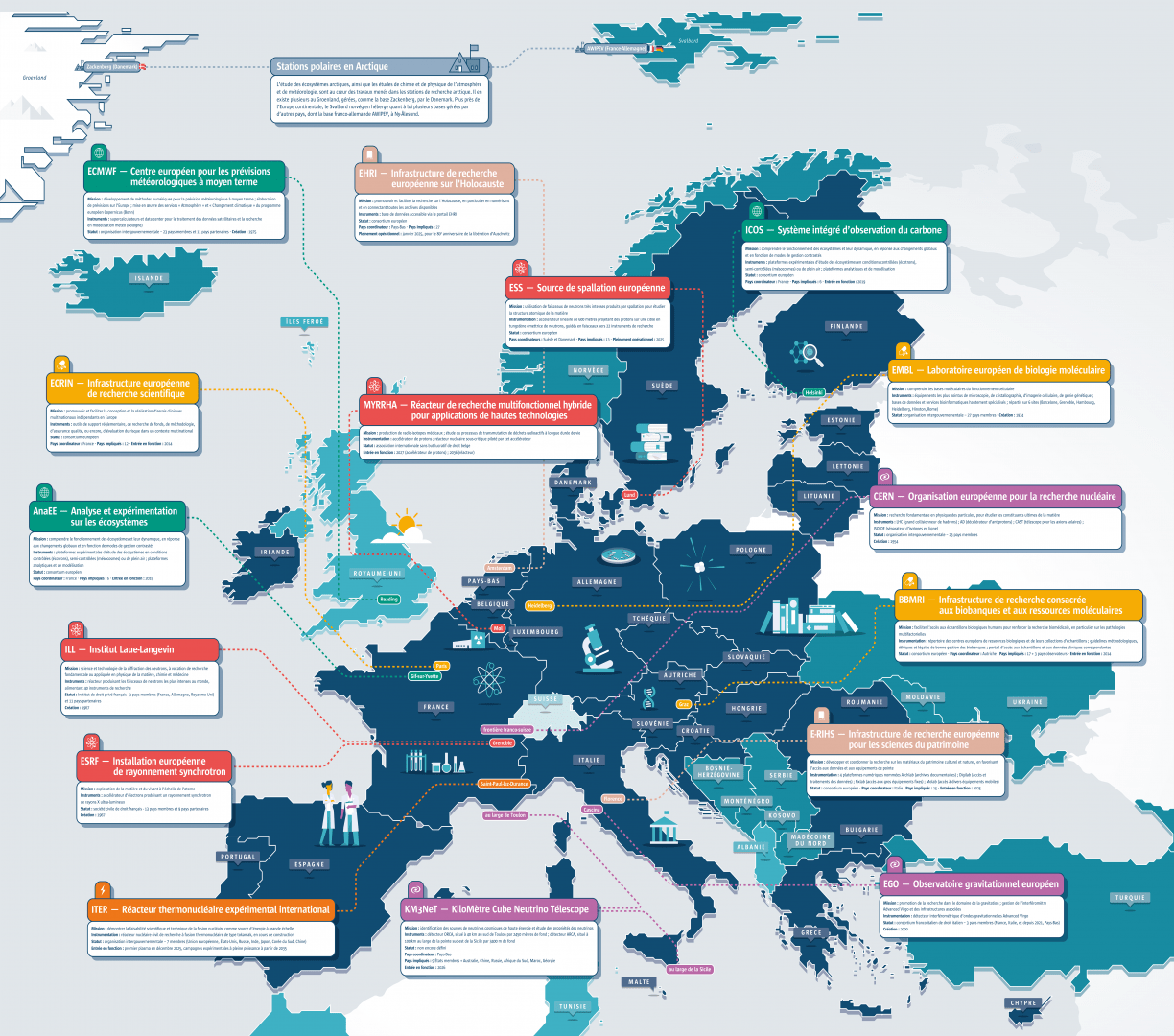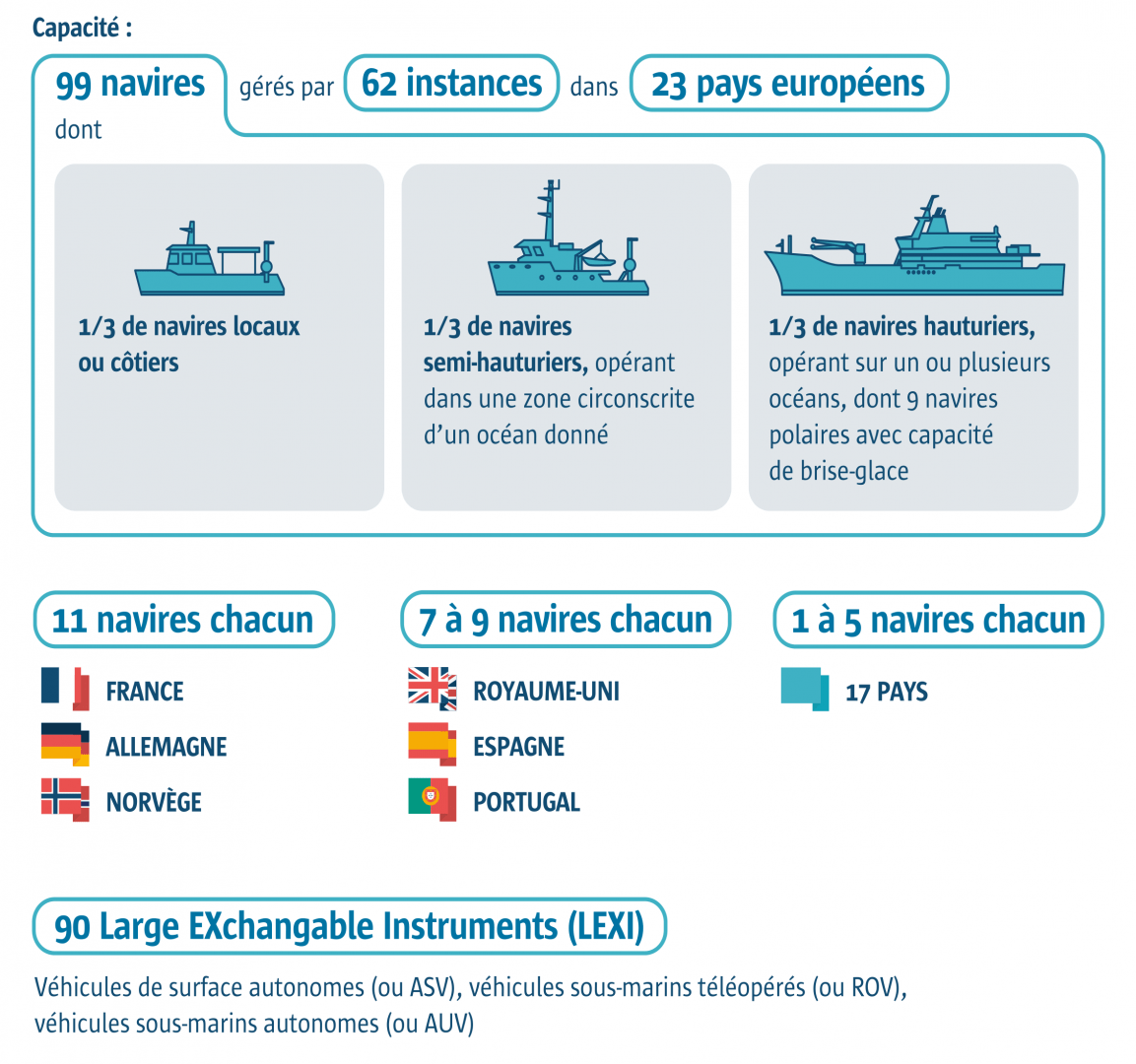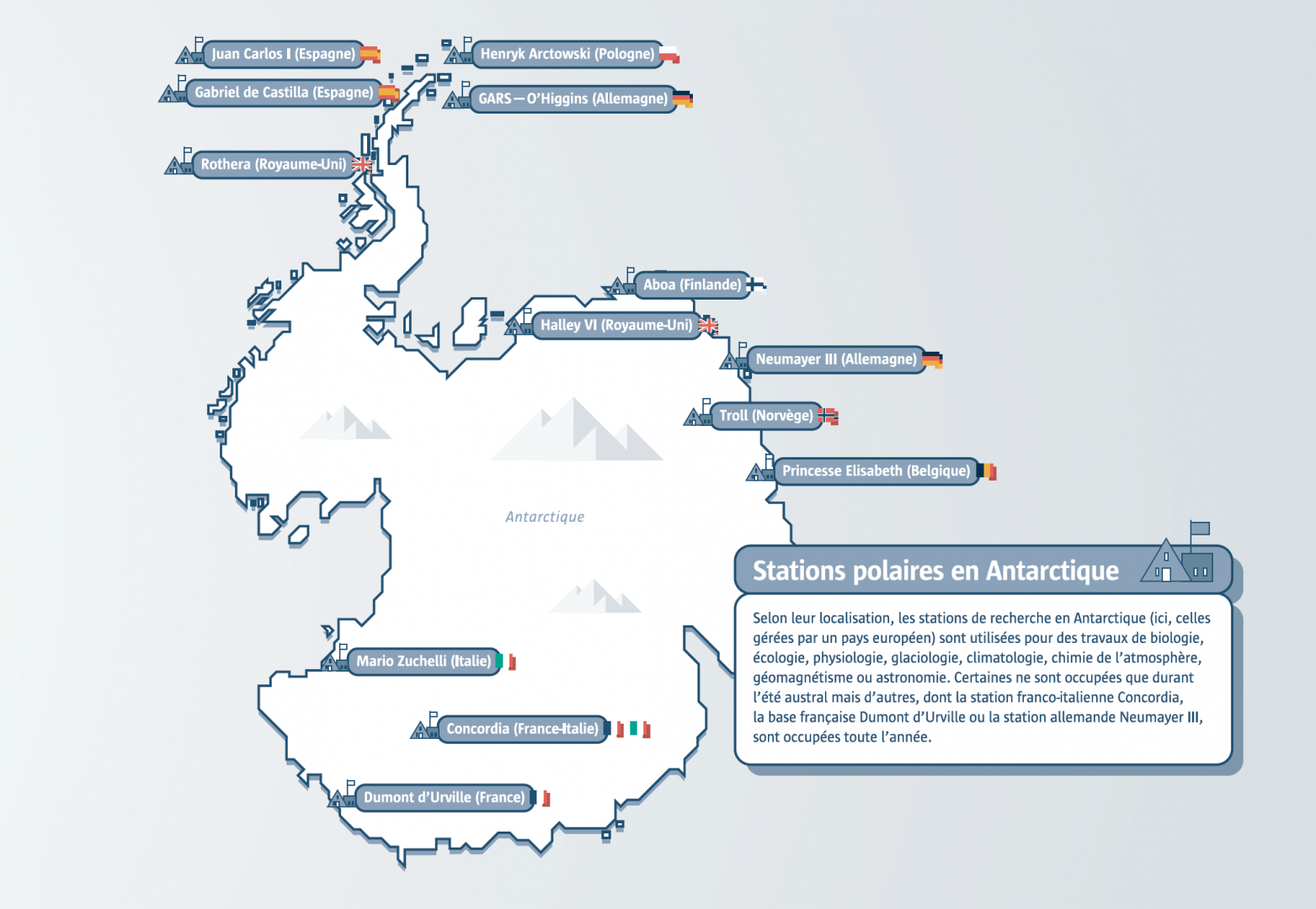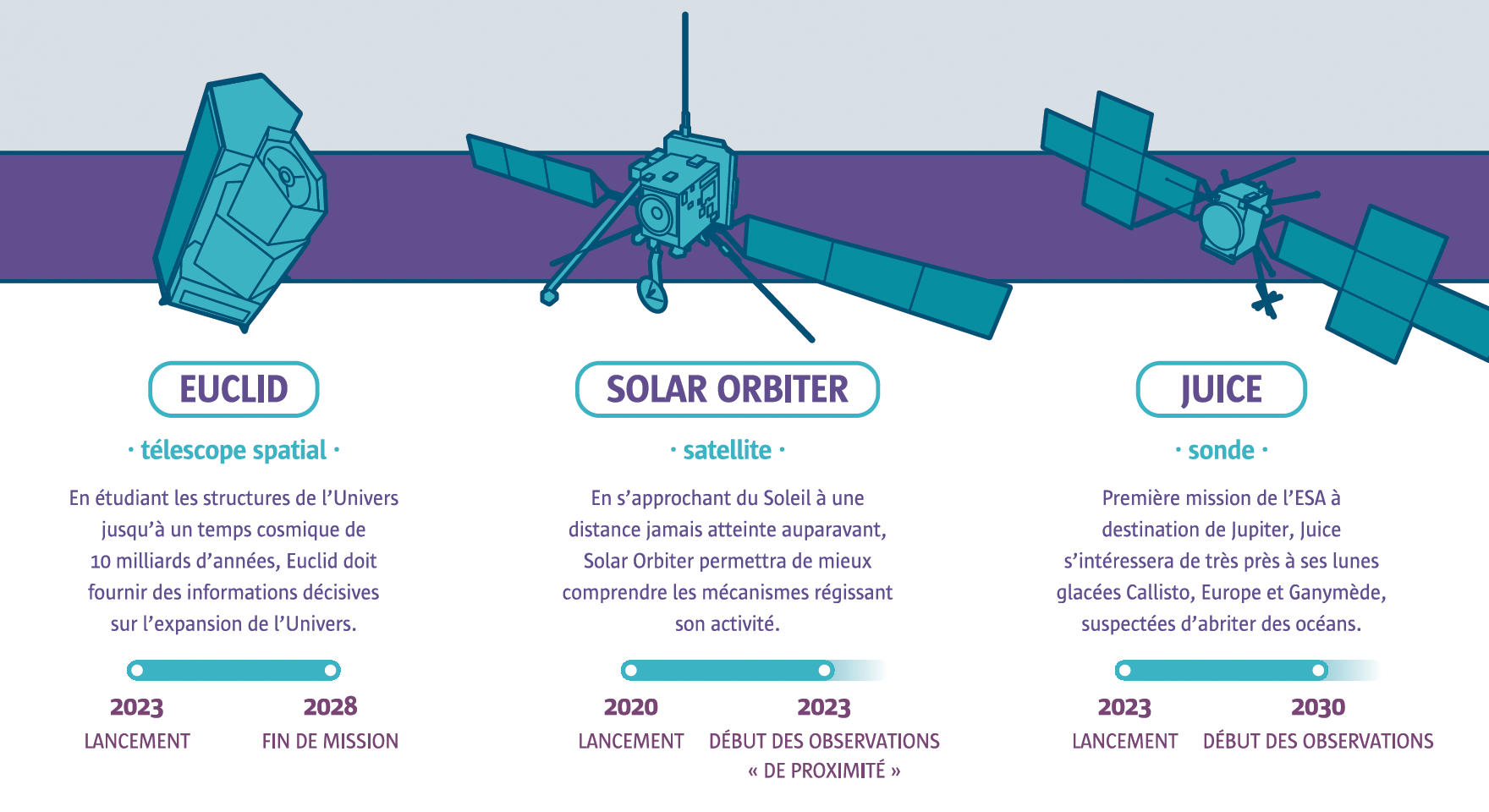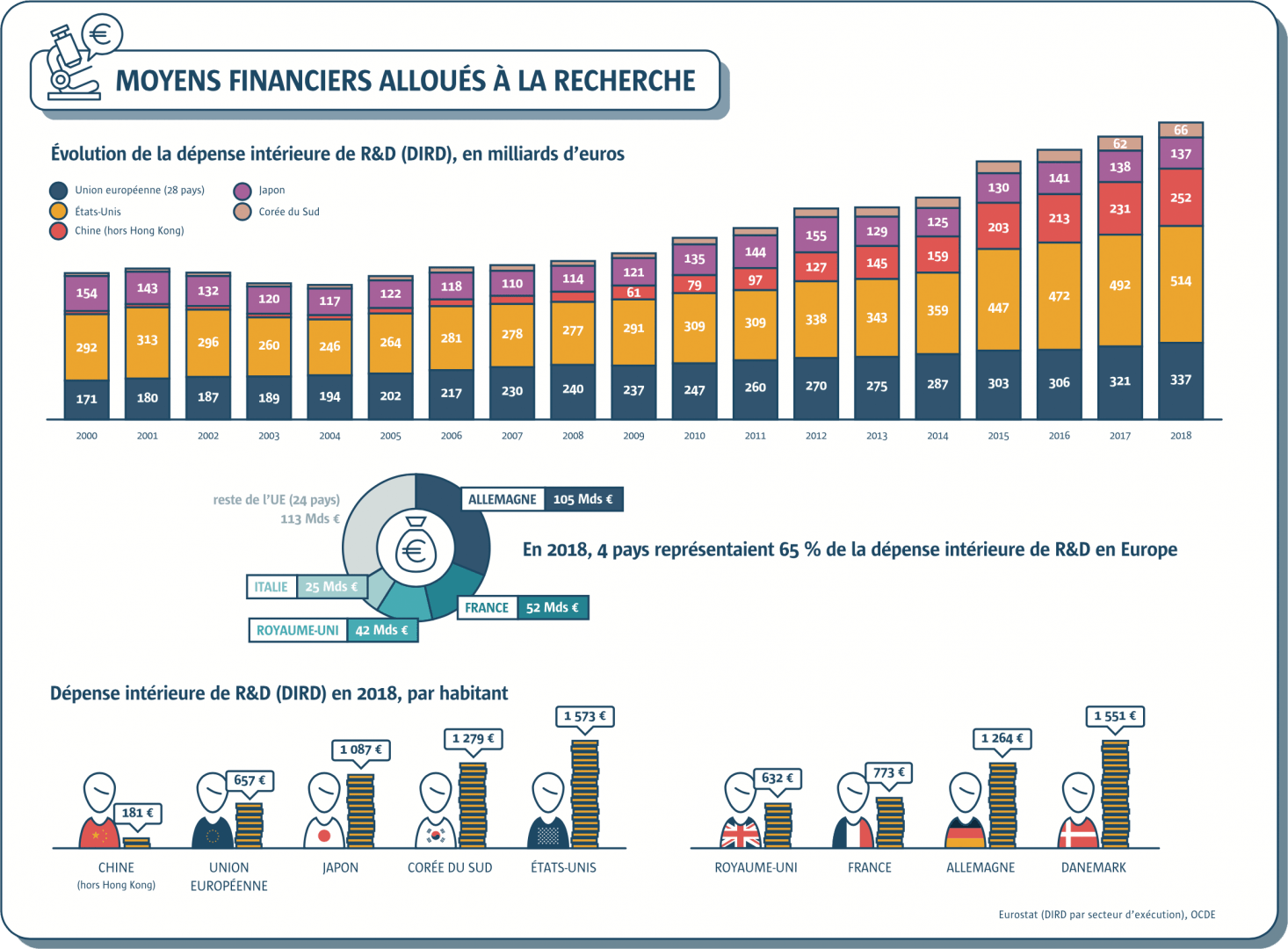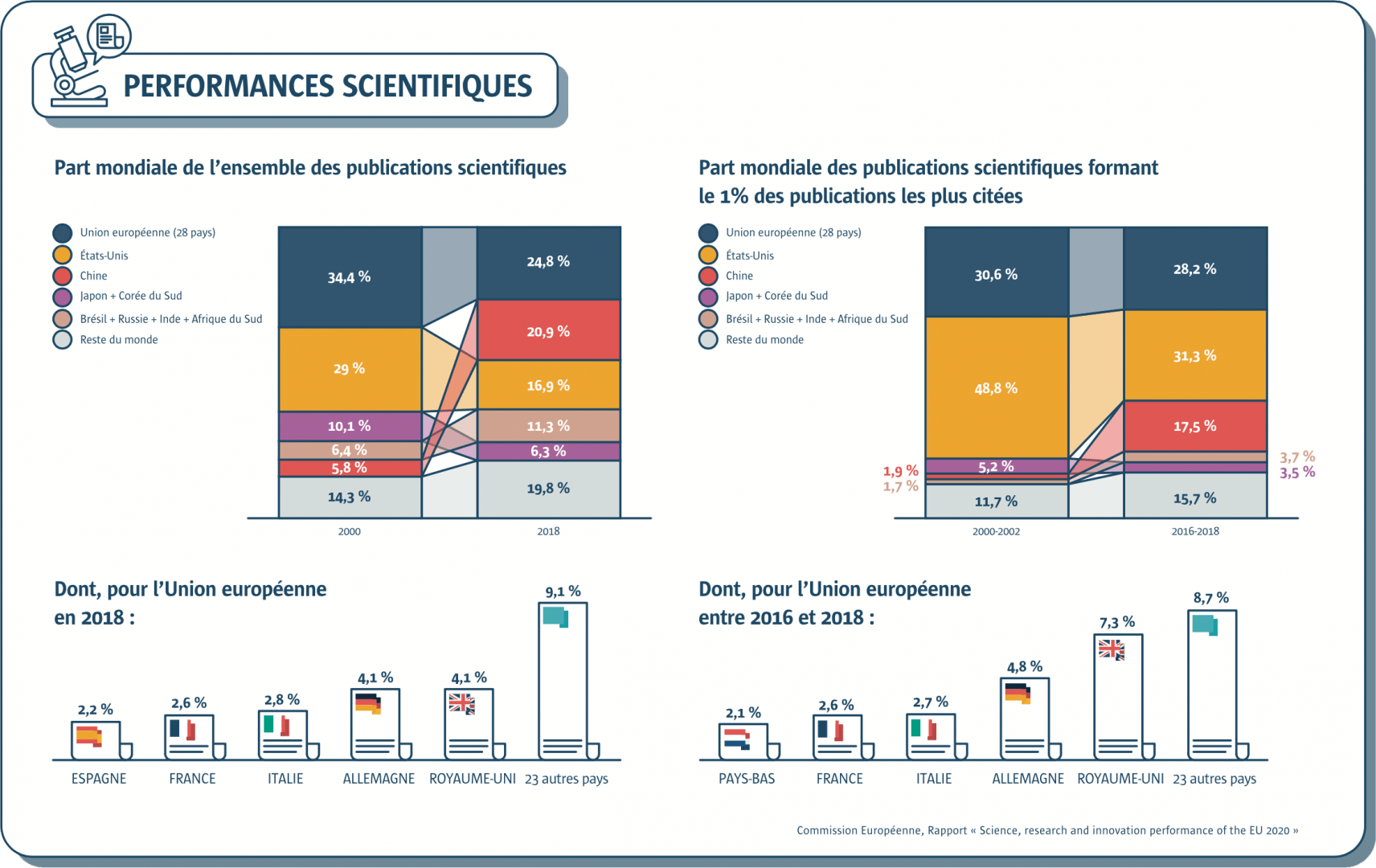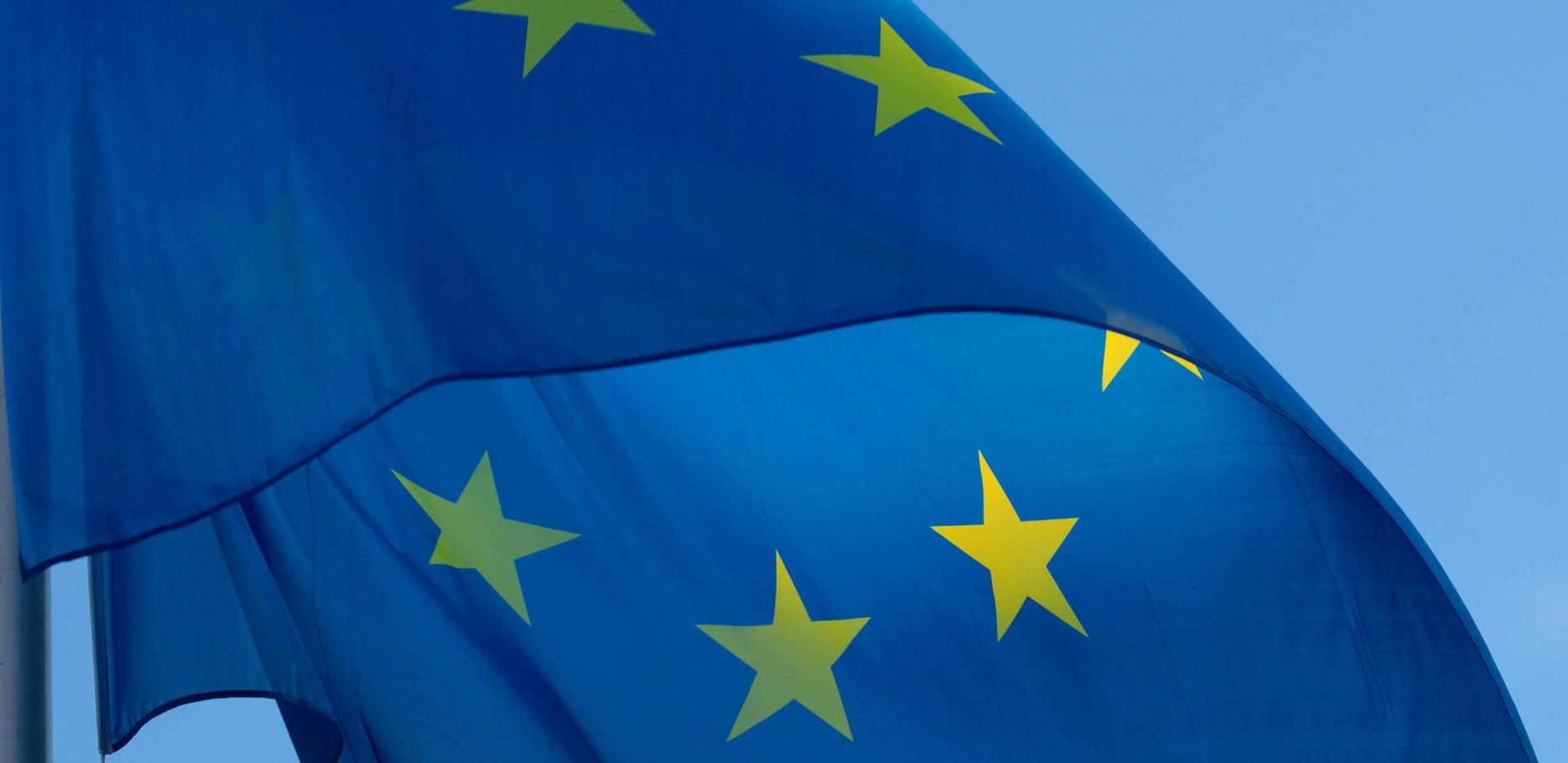
Europe of Research
Air, space, land, oceans, physics, chemistry, geology, biology, medicine, human sciences… Europe’s huge research infrastructure – sometimes situated outside the continent – explores every field of knowledge. Some parts are located on a single site; others are multisite and networked; finally, still more are virtual. Here is a selection of some of that infrastructure, existing today or yet to come, illustrating its diversity.
Investigation: Cécile Klingler- Computer graphics: Julien Tredan-Turini - Published on
Large-scale facilities
Non-exhaustive list

EHRI – European Holocaust Research Infrastructure
Mission: to promote and facilitate research into the Holocaust, especially by digitising and connecting all available records. Instruments: database accessible via the EHRI portal
Status: European consortium · Coordinating nation: the Netherlands · Countries involved: 27
Fully operational: January 2025, for the 80th anniversary of the liberation of Auschwitz
E-RIHS – European Research Infrastructure for Heritage Science
Mission: to develop and coordinate research into cultural and natural heritage materials, facilitating access to data and state-of-the-art equipment. Instruments: 4 digital platforms named Archlab (documentary archives); Digilab (data access and processing); Fixlab (access to large static equipment); Molab (access to various types of mobile equipment)
Status: European consortium · Coordinating nation: Italy · Countries involved: 15
Comes into service: 2025
ITER – International Thermonuclear Experimental Reactor
Mission: to demonstrate the scientific and technical feasibility of nuclear fusion as a large-scale energy source. Instrumentation: ‘Tokamak’ civil nuclear research thermonuclear fusion reactor under construction.
Status: intergovernmental organisation · 7 members (European Union, United States, Russia, India, Japan, South Korea, China)
Comes into service: first plasma in December 2025, full-power experimental campaigns from 2035
BBMRI – Biobanking and BioMolecular Resources Research Infrastructure
Mission: to facilitate access to human biological samples to assist biomedical research, particularly into multifactorial diseases. Instrumentation: index of European biological research centres and their collections of samples; methodological, ethical and legal guidelines for the proper management of biobanks; portal providing access to samples and the corresponding clinical data.
Status: European consortium · Coordinating nation: Austria · Countries involved: 17 + 3 observer countries
Came into service: 2014
ECRIN – European Clinical Research Infrastructure Network
Mission: to promote and facilitate the planning and execution of independent multinational clinical trials in Europe. Instruments: assistance tools related to regulation, the search for funding, methodology, quality assurance and the assessment of risks in a multinational context.
Status: European consortium · Coordinating nation: France · Countries involved: 12
Came into service: 2014
EMBL – European Molecular Biology Laboratory
Mission: to understand the molecular bases of cell function. Instruments: the most advanced equipment in microscopy, crystallography, cell imaging and genetic engineering; highly specialised bioinformatics databases and services; distributed over 6 sites (Barcelona, Grenoble, Hamburg, Heidelberg, Hinxton, Rome)
Status: intergovernmental organisation · 27 member states · Creation: 1974
Sentinel Satellites
Mission: to continuously supply Copernicus – the European Earth observation and monitoring programme (land, oceans, atmosphere) – with radar and optical images, altimetry data and information on atmospheric composition. Instrumentation: 6 satellites already launched; other launches scheduled between now and 2030.
Organisations responsible: European Space Agency (ESA) and EUMETSAT · First launch: Sentinel 1-A, 3 April 2014, on a Soyuz launch vehicle lifting off from the Guiana Space Centre
ECMWF – European Centre for Medium-Range Weather Forecasts
Mission: development of digital techniques for medium-range weather forecasting; preparation of forecasts for Europe; deployment of the ‘Atmosphere’ and ‘Climate Change’ services of Europe’s Copernicus programme (Bonn). Instruments: supercomputers and data centre for the processing of satellite data and research into weather modelling (Bologna).
Status: intergovernmental organisation · 23 member states and 11 partner countries · Creation: 1975
AnaEE – Analysis and experimentation on ecosystems
Mission: to understand the working of ecosystems and their dynamics in response to global changes and according to contrasting management methods. Instruments: experimental platforms for research into ecosystems in controlled conditions (ecotrons), semi-controlled conditions (mesocosms) or the open air; analytical and modelling platforms.
Status: European consortium · Coordinating nation: France · Countries involved: 6 · Came into service: 2019
ESS – European Spallation Source
Mission: to use extremely intense neutron beams produced by spallation to study the atomic structure of matter. Instrumentation: a 600-metre linear accelerator firing protons at a tungsten target that emits neutrons, which are formed into beams directed towards 22 research instruments. Status: European consortium · Coordinating nations: Sweden and Denmark · Countries involved: 13
Fully operational: 2025
MYRRHA – Multifunctional hybrid research reactor for hi-tech applications
Mission: production of medical radioisotopes; the study of processes for the transmutation of high-level radioactive waste. Instrumentation: proton accelerator; subcritical nuclear reactor driven by the accelerator.
Status: international non-profit association under Belgian law
Comes into service: 2027 (proton accelerator); 2036 (reactor)
ILL – Institut Laue-Langevin
Mission: science and technology of neutron diffraction, for fundamental or applied research in matter physics, chemistry and medicine. Instruments: reactor producing the world’s most powerful neutron beams, supplying 40 research instruments.
Status: French private-law institute · 3 member states (France, Germany, United Kingdom) and 11 partner countries · Creation: 1967
KM3NeT – Cubic Kilometre Neutrino Telescope
Mission: identification of sources of high-energy cosmic neutrinos and the study of neutrino properties. Instruments: ORCA detector, located 40 km to the south of Toulon (sea depth 2,450 metres); ARCA detector, located 100 km off the southeast point of Sicily (sea depth 3,400 metres). Status: not yet determined · Coordinating nation: Netherlands · Countries involved: 9 member states + Australia, China, Russia, South Africa, Morocco, Georgia
Comes into service: 2026
EGO – European Gravitational Observatory
Mission: promotion of research in the field of gravitation; management of the Advanced Virgo interferometer and associated infrastructure. Instrumentation: Advanced Virgo interferometer detector of gravitational waves.
Status: French-Italian consortium under Italian law · 3 member states (France, Italy and, since 2021, the Netherlands) · Creation: 2000
CERN – European Organisation for Nuclear Research
Mission: fundamental particle physics research to study the ultimate components of matter. Instruments: LHC (Large Hadron Collider); AD (antiproton decelerator); CAST (axion solar telescope); ISOLDE (online isotope separator).
Status: intergovernmental organisation · 23 member states · Creation: 1954
ESRF – European Synchrotron Radiation Facility
Mission: exploration of matter and life on the atomic scale. Instruments: electron accelerator producing synchrotron radiation of ultra-brilliant X-rays.
Status: civil company under French law · 13 member states and 9 partner countries · Creation: 1967
ICOS – Integrated Carbon Observation System
Mission: standardized measurements of atmospheric concentrations of greenhouse gases (GHGs); characterization of GHG fluxes between the atmosphere, terrestrial ecosystems and the oceans. Instruments: 140 greenhouse gas measuring stations
Status: European consortium · Coordinating country: Finland · Countries involved: 13 · Start of operation: 2016
ESO – European Southern Observatory
Mission: design, construction and management of the instruments and observatories of the ESO on the 3 Chilean sites of La Silla, Chajnantor and Cerro Paranal. Instrumentation: telescopes and associated instruments including the 3.6-metre telescope serving the HARPS ‘exoplanet hunter’ spectrograph (at La Silla); ALMA, the most powerful telescope for the observation of the Cold Universe (Chajnantor); the Very Large Telescope (Cerro Paranal) and, in 2027, the Extremely Large Telescope (Cerro Armazones)
Status: intergovernmental organisation · 16 European states + Chile (host country) · Creation: 1962
Oceanographic fleet
Mission: research programmes studying biology, ecology, halieutics, ocean chemistry, geology, seismology, palaeoclimatology, ocean and atmosphere interactions… Capacity: 99 vessels managed by 62 bodies in 23 European countries
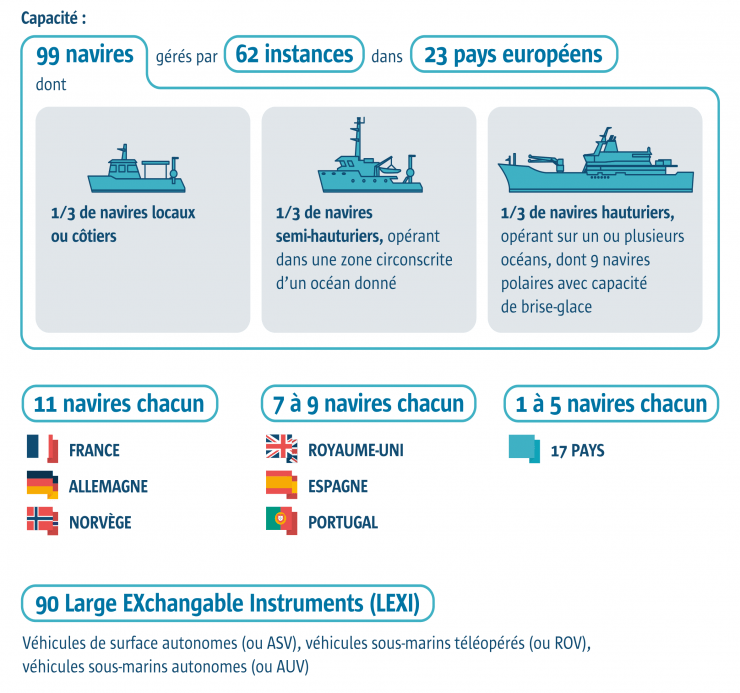
Arctic polar stations
The study of Arctic ecosystems, together with research into the chemistry and physics of the atmosphere and meteorology, are central to the work done at Arctic research stations. A number of them in Greenland are, like the Zackenberg base, managed by Denmark. Nearer to continental Europe, Norway’s Svalbard hosts several bases run by other countries, including the French-German AWIPEV base at Ny-Ålesund.

Antarctic polar stations
Depending on their location, Antarctic research stations (here, those run by a European country) are used for research into biology, ecology, physiology, glaciology, climatology, atmospheric chemistry, geomagnetism and astronomy. Some are only inhabited during the southern summer, but others – such as the French-Italian Concordia station, France’s Dumont d’Urville base and Germany’s Neumayer III station – are occupied all year round.
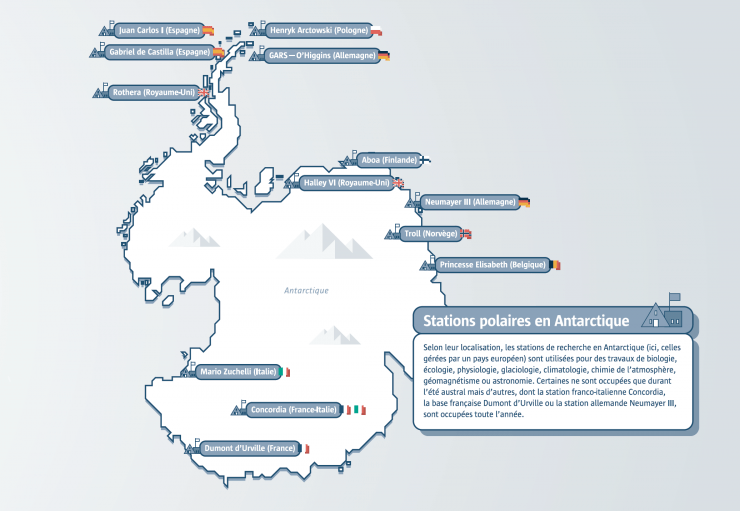
Space
On the night of 13 to 14 March 1986, during the first European deep space mission, the ESA’s Giotto probe overflew Halley’s Comet. Thirty-six years later, probes, satellites and space telescopes are constantly increasing our knowledge of the Universe.
Euclid · space telescope · Studying the structures of the Universe back to a cosmic age of 10 billion years, Euclid should provide decisive information on the expansion of the Universe. 2023-2028
Solar Orbiter · satellite · Approaching the Sun more closely than ever before, Solar Orbiter will improve our understanding of the processes that govern its activity. 2020-2023
Juice · probe · The first ESA mission to Jupiter, Juice will closely examine its ice moons – Callisto, Europa and Ganymede – which may have oceans. 2023-2030
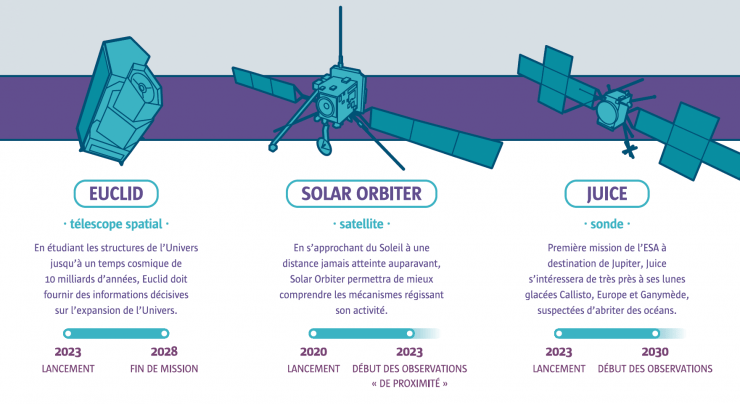
Resources allocated to research
Human resources
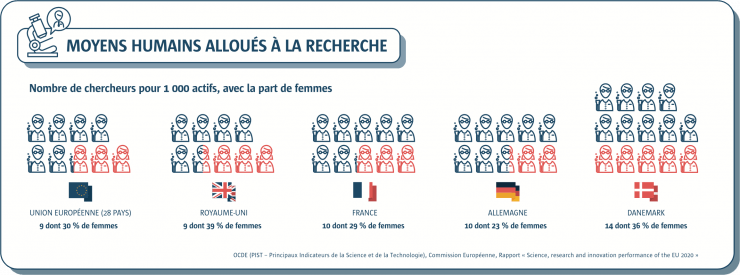
Financial resources
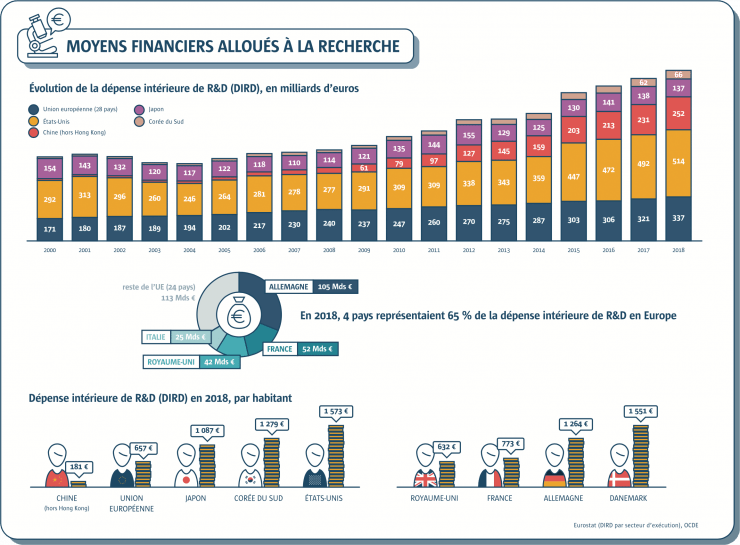
Scientific achievements
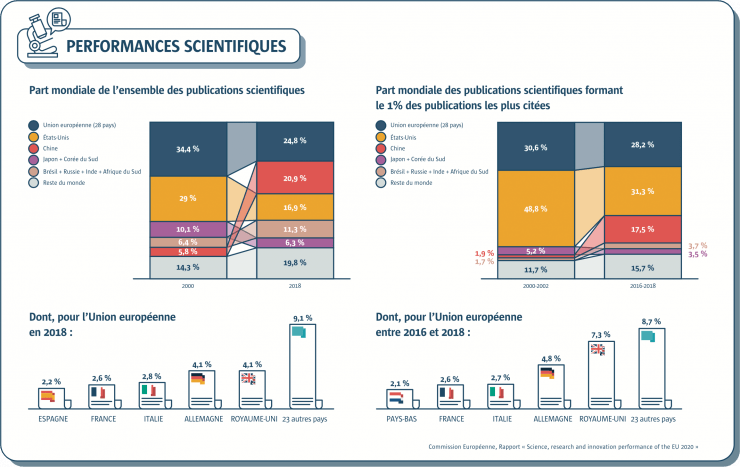
Horizon Europe (2021-2027)
Like its predecessors, the European Union’s 9th Framework Programme for Research and Technical Development, Horizon Europe, is open to EU member states, but also non-member states accepted as ‘associated countries’ or ‘non-associated third countries’ following negotiations. Members: the member states of the European Union (EU)
Associated countries (confirmed on 17th December): this status enables the nations involved to join Horizon Europe under the same terms as member states, but subject to specific limitations related to certain programmes.
Associated countries (negotiations in progress on 17th December)
Non-associated third countries (2021): the status of non-associated third countries enables them to participate in most of the programmes of Horizon Europe, but without receiving funding from the European Union (except for certain low or mid-income countries).
Sources: European Commission, DGRI News Alerts, CERN, ILL, ESRF, EMBL, ESFRI (European Strategy Forum on Research Infrastructures), ITER, ESO, Copernicus, ESA, EMB (European Marine Board), EPB (European Polar Board), and the dedicated website of each infrastructure.
